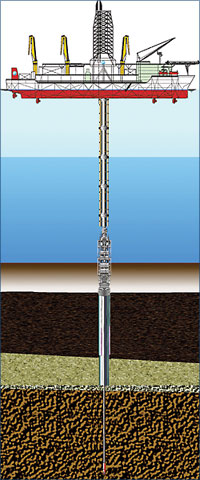| Web Japan > NIPPONIA No.33 > Special Feature* |
|
|
|
NIPPONIA No.33 June 15, 2005 |
|
Special Feature*
Discovering why earthquakes occur
The deep crustal drilling vessel Chikyu
In Japan, the clock is ticking toward the July 2005 completion of the Chikyu, a vessel that will drill deep into the earth's crust to collect rock samples. Its drill will be able to extend to sea floors as deep as 2,500 meters, and then drill an additional 7,000 meters into the crust. The dimensions of the Chikyu are impressive: length, 210 meters; width, 38 meters; total displacement, 57,500 tons. Construction costs weigh in at 60 billion yen. A drilling tower rising 121 meters above the water surface stands in the middle of the vessel, surrounded by cranes. A large helicopter landing pad is located at the bow.
The idea to construct a vessel to drill deep into the earth's crust came from Dr. Taira Akihiko, Director General, Center for Deep Earth Exploration, which will operate the Chikyu. He explains, " If we begin drilling at 2,500 meters under the sea and go down an additional 7,000 meters, we will be able to reach the boundary between a tectonic plate and the earth's mantle. If we succeed, we will reach the mantle under the oceanic crust, something never done before! And obtaining and analyzing rock samples from a tectonic plate and the mantle may help us understand crustal movements, as well as certain processes that have implications for global climate change."
The most exciting possibility is that we may finally be able to understand the plate mechanisms that produce magnitude-8 earthquakes. " We assume that one cause of major earthquakes is the release of energy that builds up because friction temporarily prevents one tectonic plate from subsiding relative to another. The interesting thing is that in some locations, such as near the Mariana Trench off the Philippines, subsidence occurs with hardly any major jolting. If we can get rock samples from there, we will have physical evidence of why earthquakes do not occur in places where you would expect them."
Knowing why major earthquakes occur or do not occur will help us predict them and may even help us prevent them one day. " If we drill deep into the crust and install sensors there, we will be able to detect what happens at or very close to the epicenter. The sensors will detect seismic movements at the epicenter and report them to us, giving us a window of 20 to 30 seconds to send out an alarm before major shock waves hit a city. That's not long, of course, but it would give people enough time to turn off the gas and dive under a desk to protect themselves. That could greatly reduce destruction and loss of life."
So far, the deepest a drill has ever penetrated under the sea floor is 2,111 meters. The drill on the Chikyu will increase this to 7,000 meters because of new riser drilling technology that circulates a special liquid at high pressure through the pipe, to prevent the drill hole from collapsing.
In 2006, the Chikyu, armed with a number of innovative technologies, will begin its work by drilling down 3,000 meters under the sea, off the Shimokita Peninsula in northern Japan. Plans call for Japan's Ocean Drilling in the 21st Century Program (OD21) to link up with an international project called Integrated Ocean Drilling Program (IODP) to promote undersea drilling in different parts of the world by 2010. One aim is to further develop drilling technology so that we will finally be able to extend a drill to a sea floor as far down as 4,000 meters, then drill an additional 8,000 meters into the planet's crust.
|
|
||||||
|
||||||
|

